- Joined
- Aug 15, 2000
- Messages
- 18,459
1st International Diamond Cut Conference
April 23-26, 2004 Moscow, Russian Federation
(Please put some photo's up all you regulars who attended - you certainly took enough! My eyes are still sore from flash lights)
Delegates summary:
Labs: AGS, EGL-USA, HRD, IGI, MSU Gem. Center and Russian Assay Office
Manufacturers: Antwerp, India, Russia and USA
Technology Companies: All Russia (Charm), Diamond Technologies, HRD Instruments, ISee2, Lexus Softmac, OctoNus, Sarin
When the three of us first discussed this conference in September 2003 we thought we would cancel it at the last minute if no-one wanted to come. In-fact we closed bookings early because of the response from the important participants. There were 18 presentations made on a range of topics. These will be released as a proceedings journal. What follows is a summary of articles of interest made from my own notes, and not yet officially endorsed by of the presenters.
Garry Holloway (Moderator)
PS A special thanks from the organizing committee is made to Gabi Tolkowsky. Gabi helped us focus on the end consumer, and the fact that diamond is a symbol of humanity. He helped make it possible for rivals to work together for the benefit of all. We came away knowing it is possible to grow the size of the pie, and our slice.
Goals and Achievements:
Overview of outcomes:
Master Stone Set
This master stone set (MSS) will be made available to all major labs (including GIA and Japanese labs who did not attend) to ensure that diamonds with similar appearance will be given similar grades by all labs. This is necessary to build consumers confidence.
The MSS should not be thought of as a grading set like color masters. It will consist of many diamonds that can be described as "good" or "bad" for a wide variety of reasons. They will be selected or manufactured to indicate various features of Basic Light Responses (e.g. light return, leakage, contrast, fire, scintillation etc) that result from various proportions and symmetry defects. We will begin with 57 facets round brilliants.
The MSS will be examined by industry experts from all levels and geographic regions. Their reported appearance will be recorded and the information compared with Basic Light Responses form 3 Dimensional models. These 3D models will be created using the most accurate scanning device (Helium from OctoNus).
Neural (fuzzy logic) statistical applications will be applied. Refinements will then require new examples of stones will be produced to find boundaries for ‘good’ and ‘bad’ for specific Basic Light Responses that result from variations in both proportions and specific symmetry variations.
Eventually the basic light responses (BLR’s) will be refined and verified to the point that it is possible to be predictive with a high degree of accuracy.
It might be expected that there will be geographic and demographic preferences. These will be quantified and can be the basis for new refinements to production, distribution and marketing of diamonds.
This process will then be applied to fancy shaped diamonds. Advantages of a predictive 3 D approach:
Major Announcements
AGS made 2 presentations, Professor Jose Sasian of the Optical Sciences Center, University of Arizona, presented a paper on the Concept of angular spectrum and its relation to gemstone illumination appeal. Jose made complex issues comprehensible. He outlined a set of 7 basic light responses; light return, static and dynamic fire, static and dynamic contrast, leakage and glare. He introduced a variant of the GilbertsonScope called Aset, a multi colored Firescope / Ideal-scope produces images that indicate the vertical direction in a virtual hemisphere where light sources could be returned by a diamond. A second observational instrument produces a FireGram image that indicates the amount of fire that a particular diamond could produce. Much of this presentation was based on the explanation of light windows; they are either open or closed, big or small etc.
Next Peter Yantzer, Director of the American Gem Society gave a full and detailed presentation of The assumptions and aspects of the forthcoming AGS Cut Grading System. Peter spoke passionately about the project adding still more detail to Jose’s paper. He introduced physical limitations such as durability, known bad proportions, poor spread, fish eye tilt etc; one bad strike and the stone is out of the top grade.
The new AGS cut grade could be released around the middle of 2005 and will be somewhat similar for round and for fancy shapes. The crown and pavilion angle ranges will be on a ‘slope’ similar in concept to early MSU charts and the Holloway Cut Adviser It can be described as a combination of parametric (like GIA's proposed system) and two direct assessment techniques. It is envisaged that actual photographic images will be displayed on reports.
Both presenters made special mention of the role that OctoNus DiamCalc software has played in their research.
Kristall Smolensk - Charm
Russia's largest diamond manufacturer, employed the Laboratory of Scientific-Research Institute of Experimental Physics of the Russian Nuclear Center to devise a diamond grading system. Director Victor Baranov presented On the introduction of a new Integral Coefficient of Diamond Beauty Brilliance. This new system combines the idea of a parametric and direct assessment, to produce a single numeric value called Charm. Above 1.0 would be most desirable, below 0.8 would be less so. The scientists created ray tracing software that produces remarkable large images of a parametrically perfect diamond. They used this software for two things. Firstly they developed values for basic light responses (BLR) of intensity (brightness) dispersion, sparkle and pattern. Using this data they produced parametric cut grade charts based on table, crown and pavilion proportions. Secondly they "verified" the system by placing 10 "charming" ladies in front of computer monitors to observe many thousands of computer generated movies on monitors. They also showed a slide of a device that is currently being patented. This photographic device will rate a diamonds "charm", accounting also for the negative effects of low color and clarity which can influence a diamonds beauty.
They have used this software to reverse engineer or predict new desirable diamond cuts. One example was an octagonal stepped cut called the ‘Stealth’ which had unusually flat proportions.
OctoNus and MSU made their first major announcement regarding their research since 1999. They outlined a system for analyzing 3 Dimensional models for any shape of diamond, irrespective of having been previously sighted. To create 3D models with the required accuracy to create high quality ray tracing models, OctoNus developed a more accurate scanner called Helium. A side benefit is manufacturers and labs will no longer need to examine diamonds with a microscope to grade craftsmanship (facet meet point) symmetry. However the main advantage of Helium is greater ‘azimuth’ accuracy. A 3 D model needs more than just facet slope or angle; we should also know very accurately the direction each facet faces. Imagine a top down view, a given crown facet might point to due north; its azimuth would be zero. The opposite side pavilion facet might point to 181 degrees or 1 degree past due South. This results in a deviation in ray paths that is important for software that calculates the BLR or basic light response for that diamond.
Yuri Shelementiev and Sergey Sivovolenko enlarged on some of the concepts that others had presented; the number and sizes of ‘virtual facets’ an observer can see in a given diamond, the effects of pupil diameter and other psycho-physical factors that have been factored into their software. The culmination of this presentation was the introduction of a new concept called ETAS or effective total angular size of predictable rays and their measurement. This is a further refinement of BLR or basic light response methods that they, and others, have previously developed and used.
They further proposed Master Stone Set (MSS) to verify the accuracy of BLR factors for all cut quality grading systems. After outlining the MSS concept Ms An Peters of HRD research facility announced that HRD will work with OctoNus to facilitate the acquisition the creation and the safe keeping of the MSS’s. Manufacturers capable of producing polished diamonds to exacting and specific requirements will be sought to produce and contribute these stones.
Some useful definitions:
Parametric cut grade systems grade a diamonds cut based on charts or scales of proportions. Examples are AGS, EGL, HRD and IGI
Direct Assessment cut grades the actual diamond with some mechanism. Examples are Brillianscope(R), Firescope(R), Ideal-Scope(R) and ISee2(R).
3D Modeling uses a scan of an actual diamond and software based expert systems to predict the diamonds basic light responses like brilliance, fire and scintillation.
(If you wish to receive a copy of the full proceedings of this conference please order online at the conference banner on the front page of www.ideal-scope.com for a cost of $40.)
April 23-26, 2004 Moscow, Russian Federation
(Please put some photo's up all you regulars who attended - you certainly took enough! My eyes are still sore from flash lights)
Delegates summary:
Labs: AGS, EGL-USA, HRD, IGI, MSU Gem. Center and Russian Assay Office
Manufacturers: Antwerp, India, Russia and USA
Technology Companies: All Russia (Charm), Diamond Technologies, HRD Instruments, ISee2, Lexus Softmac, OctoNus, Sarin
When the three of us first discussed this conference in September 2003 we thought we would cancel it at the last minute if no-one wanted to come. In-fact we closed bookings early because of the response from the important participants. There were 18 presentations made on a range of topics. These will be released as a proceedings journal. What follows is a summary of articles of interest made from my own notes, and not yet officially endorsed by of the presenters.
Garry Holloway (Moderator)
PS A special thanks from the organizing committee is made to Gabi Tolkowsky. Gabi helped us focus on the end consumer, and the fact that diamond is a symbol of humanity. He helped make it possible for rivals to work together for the benefit of all. We came away knowing it is possible to grow the size of the pie, and our slice.
Goals and Achievements:
- To build consumers confidence in diamond purchases, infrastructure will be created for the verification of any diamond cut quality grading system based on master stones that will be examined in standardized illumination by various trade experts.
- This will aid development of new cuts and improve the beauty and manufacturing yields for existing diamonds.
- A "community" has been established between the majority of attendees and organizations.
Overview of outcomes:
- Master Stone Set
This master stone set (MSS) will be made available to all major labs, including GIA and Japanese labs who did not attend, to ensure that diamonds with similar appearance will be given similar grades by all labs. This is necessary to build consumers confidence.
- Chat site for conference attendees
To be hosted on www.cutstudy.com and open only to attendees. The forum will also communicate information to the industry and the public.
- Major announcements
AGS showed all their cards regarding the development of their new round and fancy cut grading system that will combine new parametric and direct assessment techniques.
Kristall Smolensk launched a new system (Charm) that combines parametric and direct assessment, developed using ray tracing techniques for some basic light responses. The system was verified by 10 "charming" ladies observing many thousands of computer generated movies on monitors. After patenting is completed, a photographic device will be released that rates a diamonds "charm". This system is also said to account for color and clarity as factors influencing a diamonds beauty.
OctoNus outlined a system for analyzing 3D models of any shape of diamond being graded. To accomplish this OctoNus developed Helium, a more accurate scanner, and they proposed a Master Stone Set (MSS) to verify the accuracy of all cut quality grading systems.
HRD will work with OctoNus to facilitate the acquisition, and safe keeping, of the MSS’s. Manufacturers capable of producing diamonds polished to exacting requirements will be sought to produce and contribute these stones.
Master Stone Set
This master stone set (MSS) will be made available to all major labs (including GIA and Japanese labs who did not attend) to ensure that diamonds with similar appearance will be given similar grades by all labs. This is necessary to build consumers confidence.
The MSS should not be thought of as a grading set like color masters. It will consist of many diamonds that can be described as "good" or "bad" for a wide variety of reasons. They will be selected or manufactured to indicate various features of Basic Light Responses (e.g. light return, leakage, contrast, fire, scintillation etc) that result from various proportions and symmetry defects. We will begin with 57 facets round brilliants.
The MSS will be examined by industry experts from all levels and geographic regions. Their reported appearance will be recorded and the information compared with Basic Light Responses form 3 Dimensional models. These 3D models will be created using the most accurate scanning device (Helium from OctoNus).
Neural (fuzzy logic) statistical applications will be applied. Refinements will then require new examples of stones will be produced to find boundaries for ‘good’ and ‘bad’ for specific Basic Light Responses that result from variations in both proportions and specific symmetry variations.
Eventually the basic light responses (BLR’s) will be refined and verified to the point that it is possible to be predictive with a high degree of accuracy.
It might be expected that there will be geographic and demographic preferences. These will be quantified and can be the basis for new refinements to production, distribution and marketing of diamonds.
This process will then be applied to fancy shaped diamonds. Advantages of a predictive 3 D approach:
- It will be a simple task to complete a fancy cut grade for any cut
- The software can "reverse engineer" to design beautiful new cuts as well as improve the appearance of existing diamond cuts
- New shapes that better utilize a variety of rough shapes will lead to improved yields.
- This could raise the value of diamond mines that produce more of certain shaped rough.
Major Announcements
AGS made 2 presentations, Professor Jose Sasian of the Optical Sciences Center, University of Arizona, presented a paper on the Concept of angular spectrum and its relation to gemstone illumination appeal. Jose made complex issues comprehensible. He outlined a set of 7 basic light responses; light return, static and dynamic fire, static and dynamic contrast, leakage and glare. He introduced a variant of the GilbertsonScope called Aset, a multi colored Firescope / Ideal-scope produces images that indicate the vertical direction in a virtual hemisphere where light sources could be returned by a diamond. A second observational instrument produces a FireGram image that indicates the amount of fire that a particular diamond could produce. Much of this presentation was based on the explanation of light windows; they are either open or closed, big or small etc.
Next Peter Yantzer, Director of the American Gem Society gave a full and detailed presentation of The assumptions and aspects of the forthcoming AGS Cut Grading System. Peter spoke passionately about the project adding still more detail to Jose’s paper. He introduced physical limitations such as durability, known bad proportions, poor spread, fish eye tilt etc; one bad strike and the stone is out of the top grade.
The new AGS cut grade could be released around the middle of 2005 and will be somewhat similar for round and for fancy shapes. The crown and pavilion angle ranges will be on a ‘slope’ similar in concept to early MSU charts and the Holloway Cut Adviser It can be described as a combination of parametric (like GIA's proposed system) and two direct assessment techniques. It is envisaged that actual photographic images will be displayed on reports.
Both presenters made special mention of the role that OctoNus DiamCalc software has played in their research.
Kristall Smolensk - Charm
Russia's largest diamond manufacturer, employed the Laboratory of Scientific-Research Institute of Experimental Physics of the Russian Nuclear Center to devise a diamond grading system. Director Victor Baranov presented On the introduction of a new Integral Coefficient of Diamond Beauty Brilliance. This new system combines the idea of a parametric and direct assessment, to produce a single numeric value called Charm. Above 1.0 would be most desirable, below 0.8 would be less so. The scientists created ray tracing software that produces remarkable large images of a parametrically perfect diamond. They used this software for two things. Firstly they developed values for basic light responses (BLR) of intensity (brightness) dispersion, sparkle and pattern. Using this data they produced parametric cut grade charts based on table, crown and pavilion proportions. Secondly they "verified" the system by placing 10 "charming" ladies in front of computer monitors to observe many thousands of computer generated movies on monitors. They also showed a slide of a device that is currently being patented. This photographic device will rate a diamonds "charm", accounting also for the negative effects of low color and clarity which can influence a diamonds beauty.
They have used this software to reverse engineer or predict new desirable diamond cuts. One example was an octagonal stepped cut called the ‘Stealth’ which had unusually flat proportions.
OctoNus and MSU made their first major announcement regarding their research since 1999. They outlined a system for analyzing 3 Dimensional models for any shape of diamond, irrespective of having been previously sighted. To create 3D models with the required accuracy to create high quality ray tracing models, OctoNus developed a more accurate scanner called Helium. A side benefit is manufacturers and labs will no longer need to examine diamonds with a microscope to grade craftsmanship (facet meet point) symmetry. However the main advantage of Helium is greater ‘azimuth’ accuracy. A 3 D model needs more than just facet slope or angle; we should also know very accurately the direction each facet faces. Imagine a top down view, a given crown facet might point to due north; its azimuth would be zero. The opposite side pavilion facet might point to 181 degrees or 1 degree past due South. This results in a deviation in ray paths that is important for software that calculates the BLR or basic light response for that diamond.
Yuri Shelementiev and Sergey Sivovolenko enlarged on some of the concepts that others had presented; the number and sizes of ‘virtual facets’ an observer can see in a given diamond, the effects of pupil diameter and other psycho-physical factors that have been factored into their software. The culmination of this presentation was the introduction of a new concept called ETAS or effective total angular size of predictable rays and their measurement. This is a further refinement of BLR or basic light response methods that they, and others, have previously developed and used.
They further proposed Master Stone Set (MSS) to verify the accuracy of BLR factors for all cut quality grading systems. After outlining the MSS concept Ms An Peters of HRD research facility announced that HRD will work with OctoNus to facilitate the acquisition the creation and the safe keeping of the MSS’s. Manufacturers capable of producing polished diamonds to exacting and specific requirements will be sought to produce and contribute these stones.
Some useful definitions:
Parametric cut grade systems grade a diamonds cut based on charts or scales of proportions. Examples are AGS, EGL, HRD and IGI
Direct Assessment cut grades the actual diamond with some mechanism. Examples are Brillianscope(R), Firescope(R), Ideal-Scope(R) and ISee2(R).
3D Modeling uses a scan of an actual diamond and software based expert systems to predict the diamonds basic light responses like brilliance, fire and scintillation.
(If you wish to receive a copy of the full proceedings of this conference please order online at the conference banner on the front page of www.ideal-scope.com for a cost of $40.)





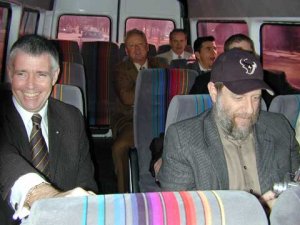
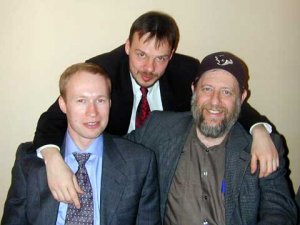
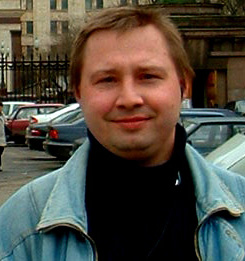


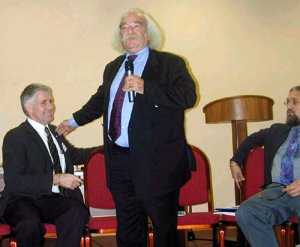

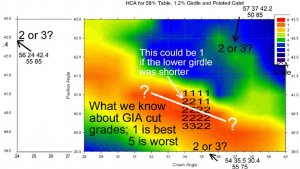


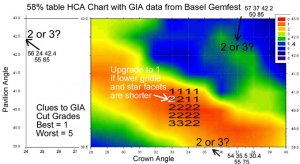


300x240.png)